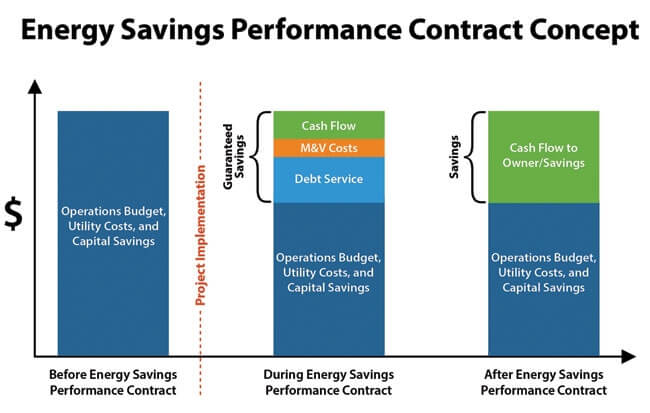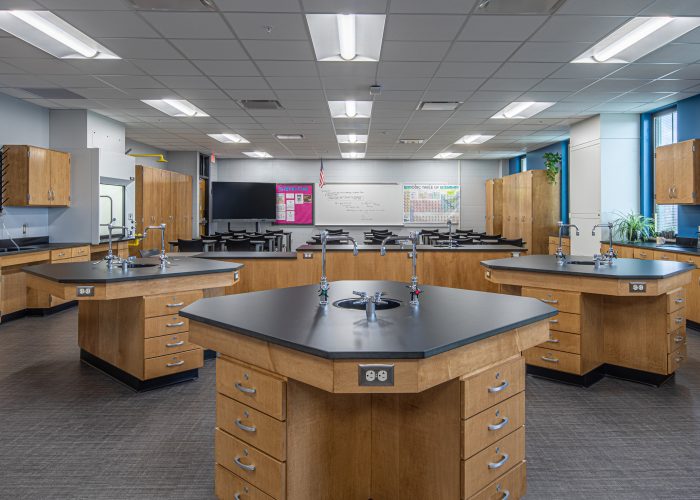Introduction
Performance contracts are a self-funding option for public owners seeking to balance fiscal responsibility with sustainable building solutions. K-12 school districts, higher education institutions, and local governments use performance-based contracts to modernize facilities, address deferred maintenance, and provide optimal learning and working environments for building occupants.
In this article, I’ll answer the critical questions about this financing mechanism and how public entities can achieve real savings.
What is a Performance-Based Contract?
Performance contracting, commonly referred to as energy savings performance contracting (ESPC) or guaranteed energy savings contracting (GESC), is a budget-neutral procurement method for public owners to implement building improvements that reduce energy, increase operational efficiency, and generate real savings. These projects do not require upfront capital. Instead, they are financed and repaid from the future energy savings generated from the efficiency improvements. For example, a public owner can retrofit lighting and pay for those upgrades with the savings/operational efficiencies LEDs provide over traditional incandescent bulbs. The upgrades save energy and provide building occupants with a more optimal indoor environment.
Once a project has been implemented, the energy services company (ESCO) monitors the performance of the energy conservation measures, with an option to monitor monthly utility bills and energy consumption to ensure the improvements operate efficiently. If the actual savings do not meet or exceed the savings in the guarantee agreement, the ESCO will pay the difference and make any necessary adjustments to achieve the agreed-upon savings. Any savings beyond the guarantee should go directly to the owner.
Below is a chart depicting the cashflows before, during, and after an energy savings performance contracting project, highlighting the cash flow generated from the project at completion.

How Does Performance Contracting Work?
Performance contracting relies on a collaborative approach between the client and the ESCO. State-enabling legislation varies, but the general process is as follows:
- Assessment and Goal Setting: The process begins with a comprehensive facility assessment of the current state of facilities and infrastructure. Goals and objectives are set, identifying energy-focused areas for improvement.
- Contractor Selection: The public owner selects a qualified provider, typically an Energy Services Company (ESCO) or, better, a NAESCO-Accredited Energy Services Company, through cooperative purchasing or through a qualifications-based selection process.
- Project Design and Proposal: The ESCO conducts a detailed analysis, designs a tailored solution, and proposes a plan outlining improvements, estimated costs, and guaranteed energy savings.
- Negotiation and Agreement: Both parties negotiate the terms, including the scope of work, performance agreements, contract duration, and measurement and verification methods.
- Implementation: Once the agreement is in place, the qualified ESCO provider will implement the proposed upgrades outlined in the contract. This phase often includes technology installations, system upgrades, and operational enhancements.
- Performance: performance monitoring takes place to ensure they meet the agreed-upon targets. This monitoring typically involves data collection, analysis, and reporting.
- Measurement and Verification: The ESCO verifies and quantifies the actual achieved results against the agreed-upon targets at specified intervals. This step ensures that the promised savings or performance improvements are being realized.
- Ongoing Maintenance and Support: Some owner agreements may include post-contract support or maintenance provisions to ensure continued performance and sustainability of the implemented measures even after the contract period ends.
Frequently Asked Question: How does performance contracting work in my state?
What Are the Benefits of Performance Contracts for Schools, Higher Education, and Cities/Towns?
Performance contracting brings a host of advantages to the table. It’s a money-saver, reducing energy usage and operational expenses. Plus, it’s a way to upgrade aging infrastructure without the upfront financial burden. And the environmental impact? It’s a win, reducing carbon footprints and resource consumption. In addition to the energy and operational savings, here are six reasons a public owner might wish to pursue performance contracting:
- Budget Neutral: Performance contracting projects are 100% financed and repaid with guaranteed energy and operational savings from the energy conservation measures (ECMs).
- Opportunity to Address Deferred Maintenance: While deferring maintenance may seem like a cost-saving strategy initially, it often increases costs in the long run. However, with performance contracting, public owners can address critical issues without upfront capital expenditures.
- Create High-Performing Buildings: Transform public buildings into more modern structures with high-efficiency equipment and technologies that save energy and generate operational savings.
- Establish Optimal Learning/Working Environments: Building performance doesn’t have to come at the expense of increased energy consumption. Performance contracts can include a variety of ECMs that can support an optimal physical environment.
- Reduce Contracting Risk: guaranteed energy savings contracts are a lower-risk venture for public owners. The risk of change orders, hidden project costs, schedule delays, and underperformance is inherently diminished because of energy savings guarantees, transparency, and long-term financial predictability.
- ENERGY STAR® Award Eligibility: ENERGY STAR® is offered by the Environmental Protection Agency (EPA) to denote a building uses less energy, costs less to operate, and provides an optimal indoor environment. Public owners can achieve this symbol of excellence and showcase their commitment to sustainability by implementing energy conservation measures.
What Types of Building Improvements Are Included in Performance Contracts?
Performance contracts can facilitate a wide range of improvements, typically focused on enhancing energy efficiency, infrastructure, and operational performance. Some common improvements installed through energy savings performance contracts include:
- Energy Efficiency Upgrades: Installation of energy-efficient LED lighting, HVAC systems, building automation systems, and renewable energy systems like solar panels.
- Building Envelope Improvements: Upgrades to windows, insulation, roofing, and other elements to improve the building’s thermal performance and reduce energy loss.
- Water Conservation Measures: Installation of water-efficient fixtures, irrigation systems, smart water meters, advanced metering infrastructures, and wastewater treatment technologies to reduce water usage and waste.
- Infrastructure Enhancements: Upgrade aging infrastructure components like boilers, chillers, pumps, and other essential systems to improve efficiency and reliability.
- Smart Technology Integration: Implementation of smart technology solutions for monitoring and controlling energy uses, such as smart meters and energy management systems.
- Renewable Energy Installations: Deploying renewable energy sources like solar panels or geothermal systems reduces reliance on traditional energy sources.
- Operational Improvements: Implementation of operational best practices, employee training programs, and maintenance protocols through Energy Leadership Programs to optimize ongoing efficiency.
These improvements aim to optimize energy consumption, reduce operational costs, enhance infrastructure reliability, and contribute to sustainability goals – all while requiring little upfront investment.
What are some case examples of public projects that utilized a performance contract to upgrade facility infrastructure?
Performance Services has worked on over 550 energy savings projects since our founding in 1998. Performance contracts have been central to our business, and our integrated design and construction approach provides real value to our clients. Below are a few recent projects that transformed the client’s facilities and achieved significant savings.
- Fort Wayne Community Schools: The District worked with Performance Services to improve the learning environment for students and staff. Over the last decade, the district has achieved more than $18 million in cumulative energy savings and 29 ENERGY STAR® certified school buildings to date.
- Glenbard Township High School District 87: The District has completed eight project phases, including improvements to four high school buildings. The projects included controls upgrades, LED lighting, roof replacements, new rooftop units, and solar arrays. The expected energy and operational savings of the project improvements over 10 years are $85 million.
- University of Arkansas at Pine Bluff: The energy savings project is a part of the university’s master plan. It impacted 30 buildings on campus, saving 32% in annual energy costs from baseline energy consumption and addressing critical infrastructure needs. In 2018, the project was awarded the Innovative Energy Project of the Year – Region IV at the Association of Energy Engineers Conference.
- City of Jacksonville, Texas: The City utilized a guaranteed energy savings contract to upgrade and install 5,452 smart water meters with zero upfront capital. The project was so significant that the City was recognized by the 2021 Smart 50 as one of 50 projects globally for its innovation and community impact.
Conclusion
Performance contracting can be a game-changer for public entities seeking a strategic, sustainable, and fiscally responsible path forward. This flexible funding mechanism helps schools and local governments prioritize critical facility improvements and benefit from significant utility savings, a win-win scenario for stretched public budgets.
Interested in more? Contact us, and our engineers will follow up to provide answers with a facility assessment.
Our team will walk your buildings, investigate your equipment, inquire about your needs, and provide prioritized needs and solutions in areas such as:
- Actional steps for improving indoor air quality
- Opportunities for energy and operational savings
- Recommendations for long-term facility planning
- Solutions to address deferred maintenance





